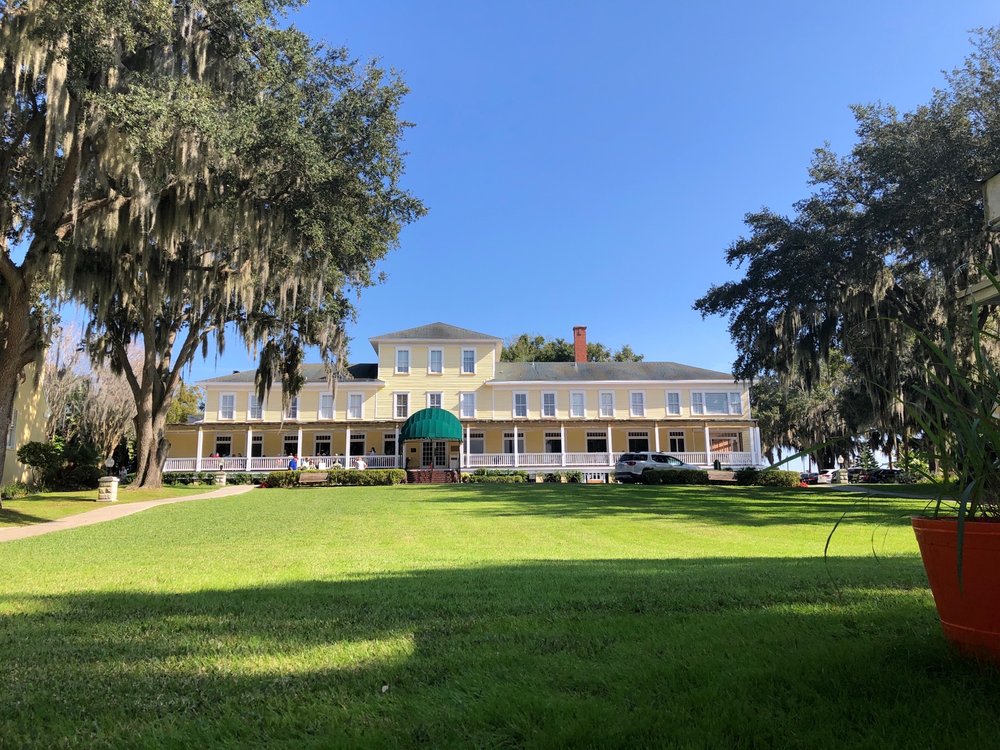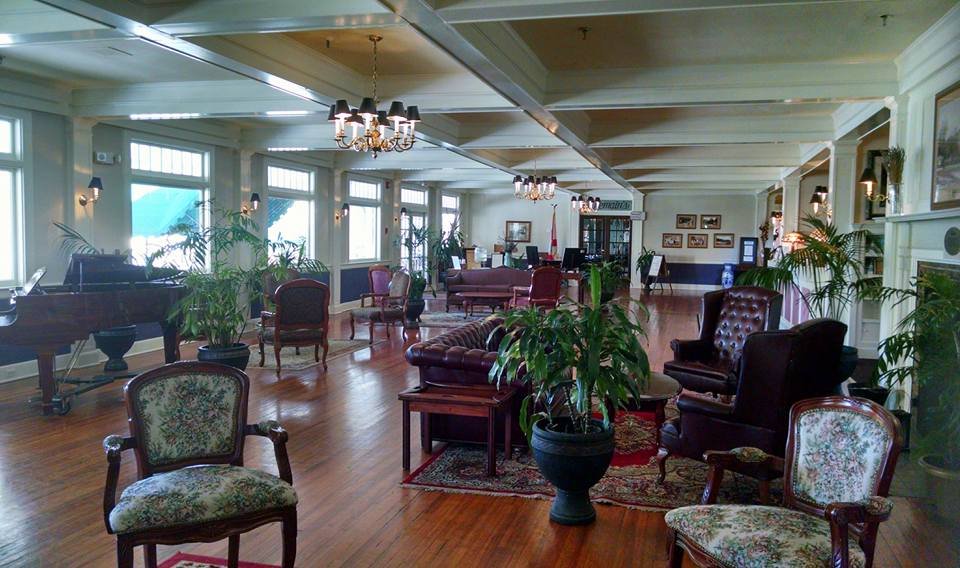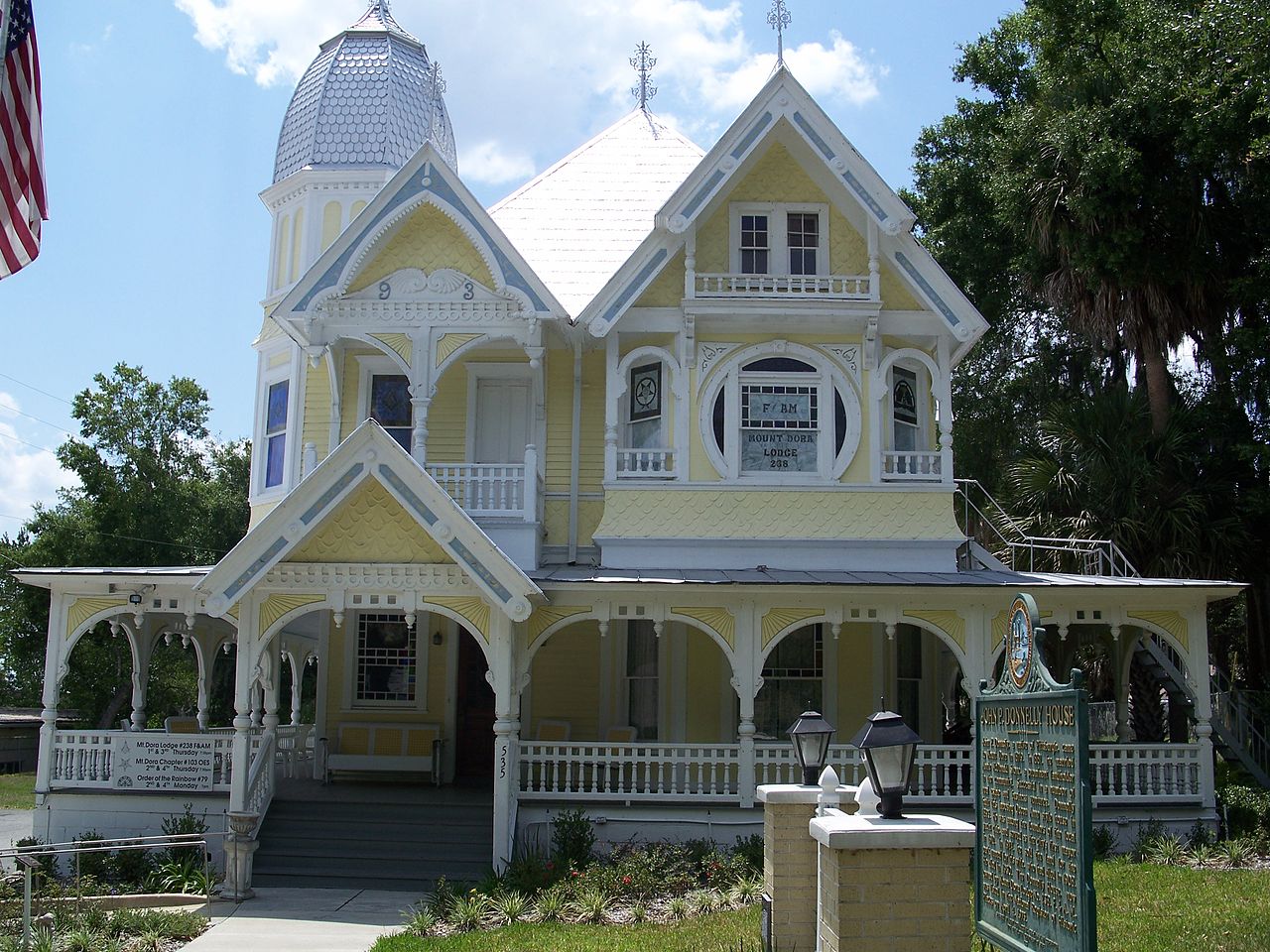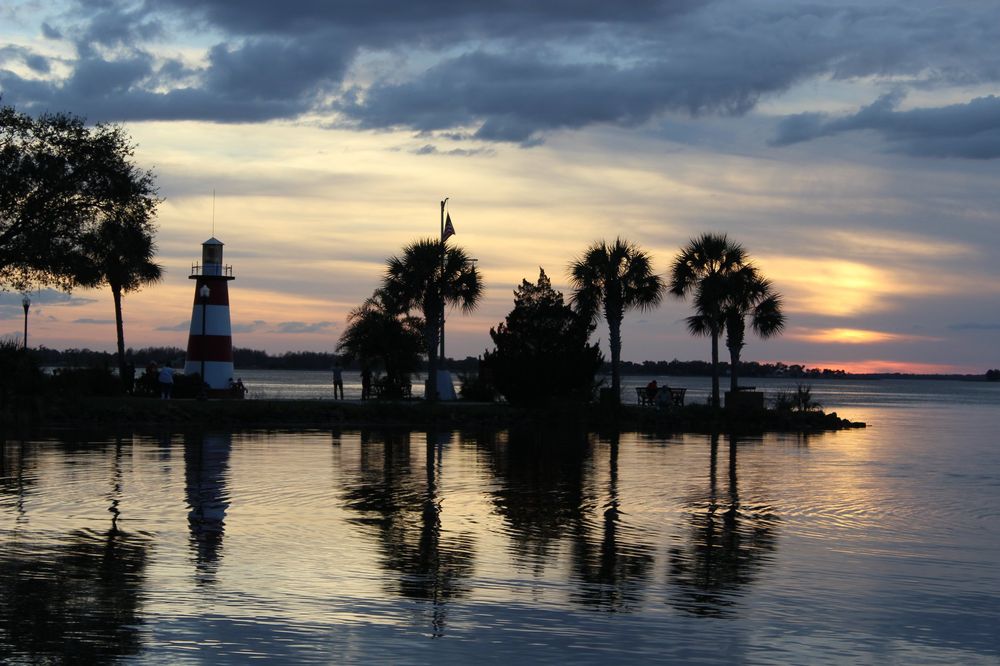Mount Dora Is A Lakeside Wonder
The Lakeside Inn
100 Alexander St., between 3rd Ave. and Lake Dora
In 1882-83, Col. Alexander, Mrs. Stone and Col. MacDonald built a ten-room Frame Vernacular two-story wooden hotel called the Alexander House on this site. It was mainly a fishing retreat for Northerners until 1895 when Emma Boone, an experienced hotel operator from Boston renamed the hotel the Lake House, and added a long lower floor.
Another building called the Gatehouse was built in 1908 by George D. Thayer just inside the front gates. Thayer built a house just to the west of the Gatehouse in 1910 and four years later started Sunset Cottage south of the later Terrace annex.

In 1924 Charles Edgerton and his son Dick bought the complex in 1924. Four years later, The Gables, a new bedroom annex, was built with Jacobethan-style elements. In 1930, The Terrace was built to the south and two years afterward, an Olympic-sized heated swimming pool was added. In the early 1930s, the complex was incorporated as the Lakeside Inn Properties.

The main structure of this hotel maintains the Victorian style as Frame Vernacular, but two of the later buildings, erected in 1926 and 1929, are stucco and have Jacobethan style elements. The inn grew to 87 hotel rooms, with meeting and banquet space for up to 150.

Mount Dora Train Depot
(341 Alexander St.)
Built in 1915, this frame vernacular style building with a tin roof was the Mount Dora passenger and freight depot until 1950. Since 1973, it has been the office of the Mount Dora Chamber of Commerce and has been placed on the National Register of Historic Places

Mount Dora Yacht Club
351 W. 4th Ave
The Mount Dora Yacht Club was organized in 1913 in the boathouse of H.C. Fuller. And the original building was completed here in the fall of 1913 and housed the oldest inland yacht club in the state of Florida. It was the social center of early Mount Dora. It burned in 1966 and was replaced by the present clubhouse.
Lake Dora was named after Dora Ann Drawdy in an 1848 government survey, prepared under the supervision of James A. Gould. She and her husband Jim had arrived in the area from Augusta, Georgia, shortly after the state was opened for homesteaders in 1846.
 .
.
H. C. Fuller House
644 McDonald St
The wood house of H.C. Fuller was built in the early 1900s. The one-story house features crossed gables, cross-hatched shingles, and a slatted diamond-shaped vent. Fuller was the first commodore of the Mount Dora Yacht Club. McDonald St. is named after Clark W. McDonald, who homesteaded the area south of Liberty Ave. in 1875
Clark McDonald Stone House
717 McDonald St
This unusual house was built in 1883 for Clark W. McDonald and his wife, Helen, who came from Toledo, Ohio. It was occupied by their daughter, Annie P. McDonald Stone before she married J.P. Donnelly. This house became an early social center of Mount Dora.
Raintree House
1123 Dora Way
This 1940s era home has been operated as the Dora Way Bed & Breakfast. Nearby is the site of one of the first orange groves in the area, planted by Doc Henry. The inn overlooks Lake Dora.

Christian Home and Bible School
200 W. 13th Ave
. In 1885, Ross C. Tremain attempted to attract the new Florida Congregational Association college, which instead settled in Winter Park as Rollins College. J.P. Donnelly and James Simpson tried to convince John B. Stetson to establish his university here, instead of DeLand. This school was established in Mount Dora in August of 1944.
Pine Forest Cemetery
In 1866, Mr. and Mrs. J.P. Donnelly set aside 2 1/2 acres to be used as Forest Cemetery. The name was changed in 1953 to Pine Forest Cemetery, because there were already 28 other cities with a " Forest Cemetery", but only one other with a " Pine Forest Cemetery. The cemetery is now 40 acres.
The first death among the settlers was Mrs. I.M. Mabbette in 1881, but her place of burial is unknown. The first for which there is a monument is the Warburton family.
The Unity House
Mount Dora Historical Society
2015 Donnelly Street
This two-story frame vernacular style house was built in 1905,. In 1992, it was saved from destruction through the efforts of the Mount Dora Historical Society. Two years later, it was moved to this location to be restored and used as the Historical Society's office
Mount Olive A.M.E. Church
1630 Grandview St
This church began holding services in a brush arbor. The present building dates from the 1890s, when Rev. Wiley Corley was the first pastor
Witherspoon Lodge
1470 Clayton Street
The Witherspoon Lodge of Free and Accepted Masons is one of the state's oldest active black Masonic lodges. Founded in 1898, it moved to this site in 1903 and holds its meetings on the second floor. The building also served as a schoolhouse from 1922 until 1925.
Milner-Rosenwald Academy
1560 Highland Street
Mount Dora's first school for black children was located here on a 63 x 132 foot lot. It had one room and burned in 1922. The Rosenwald Foundation provided a grant of $13,000 which was used to build the present four-room school building in 1926. It was named the Milner-Rosenwald Academy to honor the foundation established by philanthropist Julius Rosenwald and benefactor Rev. Duncan C. Milner. It was replaced by a new building at 1250 Grant Ave. which in the 1970s was renamed as Mount Dora Middle School.
Ice House Theater Site
1100 N. Unser St
This building served as an ice storage plant (built by James W. Simpson and George Patterson), a citrus packing plant, and a World War II youth center. After the considerable renovation, it opened as a theater in February of 1949. The Ice House Players later had this modern building constructed.on the site.
Hoagland House
849-851 Donnelly Street
This downtown building was originally the home of the Hoagland family, built-in 1896, and later in 1952 the Kilkare Convalescent Rest Home, managed by Nancy A. McWhinnie from New York City. In later years, it was used as executive rental offices.

J. G. LaDue House
225 9th Ave
This was the home of J.G. (Jerome) LaDue, one of the members of the Mount Dora Development Corp. He and wife Julia bought an orange grove here which had been started by Miss Boone of the Lakeside Inn. They built their house, and Jerome died in 1924. The house features a stamped tin roof and a side bay window
Alexander House
207 E. 8th Ave
This L-shaped house was built in the early 1880s, this was the home of Col. Alexander who owned and operated the first general store in Mount Dora.
Mount Dora Community Building
This Spanish style building with Moorish arches has served as a cultural and social center since it was erected in 1929
Educational Hall
308 E. 5th Ave
The first private school in Mount Dora was located in the home of Margaret Lewis. She became the first teacher in Educational Hall, as soon as it was established.
In 1912, a group of concerned citizens formed the Mount Dora Education Society. The fundraising efforts of James W. Simpson and W.F. Warden resulted in $1,500 which was used to erect this building in 1912 as a private school for winter visitors. It was named Educational Hall, and served students here until 1923, when the public school's quality was improved sufficiently to handle the needs of the children. The building was the home of the Mount Dora Public Library.
Charles Edgerton bought the vacated building, intending to sell it to the city when it had enough money. The library was moved from the basement to the upstairs, and on February 6, 1929, the city bought it. Later, when a new library was needed, the city rejected the idea of tearing it down and replacing it on the same site, because of a lack of adequate parking.
 _
_

Roseborough Elementary School
In 1920, this lot was bought for the construction of a public school, which cost $3,250. It opened in September of 1922. Six classrooms were added in 1926, and six more in 1933. Four more classrooms, plus a gymnasium and shop were added in 1941. In 1954, the cafetorium and four more rooms were added. The swimming pool was completed the following year. In 1957, two more classrooms were added. This later became part of Mount Dora High School.
J. E. MacGowen House
512 3rd Avenue
This two-story home was built in 1883 for J.E. MacGowen, one of the earliest settlers in Mount Dora. It was later owned by Frank G. Fowler
-------------------------------------------------------------------------------------------------------------------------------
 -
-

H. N. Gates House
601 First Avenue
This home of H.N. Gates was built in 1883 with a stamped tin roof and an unusual second-story porch. For a time, it was also the home of Adam Hazelwood, one of the early mayors of Mount Dora

John H. Vrooman House
539 West Liberty Avenue
General Contractor and builder John H. Vrooman lived in this 1887 home with his wife, Almeda Cecelia, the daughter of Dr. C.R. Gilbert. It features a corrugated steel roof and a central chimney.
It is now operated as Christopher's Inn, a bed a breakfast establishment
Lawn Bowling Club
125 Donnelly Street
The Mount Dora Bowling Club was organized on April 7, 1928. The city built three lawn bowling rinks here, in a portion of Evans Park. The club's first chairman was Charles Edgerton, honored by a plaque on these grounds. The club now is one of the largest with more than 300 members and is the host of major tournaments each year
Royellou Museum
450 Royellou Lane
In 1922-23, this building was erected as the town's firehouse, on land deeded to the town by J.P. Donnelly. Later, five jail cells and a bathroom were added in the back so the building could double as the police station. When the new firehouse was built in 1941 on Fourth Ave. between Donnelly and Alexander Sts., four cells were added in the front of this building, which continued to serve as the police station.
The new police/fire complex was built at the corner of Third Ave. and Donnelly St. in 1969, and this building became the sign shop for the traffic department of the police force. In 1978, it was turned into a museum by the Mount Dora Historical Society, officially dedicated on July 4, 1979. The Society has owned the building since 1993.
The two small rooms which now serve as the museum office and the storage room were formerly the public restrooms, with the doors opening on the alley. The barred cells now exhibit rooms, showing objects of historical interest which are changed periodically

Parkview Building
138 Fifth Avenue
This building was erected in 1923, and was later owned by E.C. Van Valkenberg from Smallwood, New York.
John P. Donnelly House
Donnelly Street and Fifth Avenue
This house was personally constructed in 1893 by John Phillip Donnelly for himself and the former Annie Stone, whom he married on August 27, 1891. It shows a Queen Anne style, with an octagonal turret and wraparound porch. In 1930, it became the Masonic Temple Lodge.
J.P. Donnelly, originally from Pittsburgh, Pennsylvania, laid out the town and served as its first mayor. He had homesteaded 160 acres in 1879, and by marrying the former wife of William D. Stone, he doubled his holdings. A building on the campus of the Montverde Academy is named after him, as thanks for his generous contributions. This home was placed on the National Register of Historic Places in 1975
Seabrook House
644 Donnelly Street
This was built as the Phillips Boarding House in the late nineteenth century. It was bought by Ed and Debbie Seabrook in 1990, and is now a bed and breakfast
Community Congregational Church
An organizational meeting of the Congregational Church was chaired by Rev. S.B. Andrews of Winter Park on December 27, 1883. Early services were held in the hall over a store at the corner of Donnelly St. and 4th Ave., and in the school near 7th Ave. Mr. and Mrs. J.P. Donnelly donated land, and the church building was sufficiently complete in 1887 to hold services.
It shows a Victorian Revival style, with an entry tower, octagonal bell cupola, and an elongated steeple. The one stained glass window dates to 1887.
In 1929, the name was changed to the Community (Congregational) Church. During that year, former president and Mrs. Calvin Coolidge spent a few weeks in Mount Dora and attended this church.
Princess Gallery Theatre
130 West Fifth Avenue
This was built in 1922 as a movie theater. Prior to then, Mary A. Lee and Fred Harding used to show movies in the city hall. Luckily, David S. Simpson completed the Princess and transferred the equipment there shortly before the city hall burned. In 1925, the screen and projector were sold, and eventually became the property of MCM Theaters, who operated at this location until 1972.
Simpson Hotel
110 West Fifth Avenue
This structure was built in 1925, and opened as a hotel in 1947. It was owned by H.J. Simpson and managed by Blanche Simpson Erlick.
First National Bank Building
100 West Fifth Avenue
James W. Simpson bought the Whitney property at this corner, including the site of Kimball's Garage, and in 1925 erected this brick building, also known as the Shamrock Building. During the same year, he helped organize the Mount Dora Bank and Trust Co., of which he became the president.
Its first office was in a small concrete block structure on the east side of Donnelly St. It later moved into this location and the bank's name was changed to the First National Bank of Mount Dora. It operated here until 1964, when it moved to another location at 7th Ave. and Donnelly St.
69 West Fifth ...Ramsey Building
This building was erected in 1895 and was the site of Mount Dora's first drugstore. During World War II, it was a Piggly Wiggly grocery store. It was later operated as the Lamppost Inn.
Dora Hotel
411 Donnelly St
This building was erected during the 1920s for use as a hotel, and continued as such into the late 1970s. It has since been remodeled for restaurant, office and retail use. One of its later names is The Renaissance.










